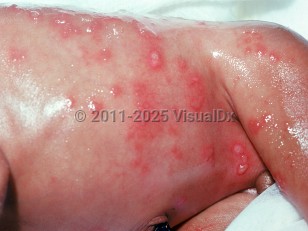Disseminated herpes simplex virus (HSV) in neonates is a potentially life-threatening condition with high morbidity and mortality. This condition requires supportive care in the neonatal intensive care unit with early administration of intravenous (IV) acyclovir. Prompt diagnosis and aggressive systemic antiviral therapy are keys to avoiding mortality or permanent sequelae.
Diagnosis Overview:
Neonatal HSV can be acquired via intrauterine, perinatal, or postnatal transmission, with perinatal transmission from the vaginal canal during birth being the most common. Neonatal HSV may be mucocutaneous or disseminated, and it can involve the central nervous system (CNS). Intrauterine (congenital) HSV infection usually presents within 2 days of birth. It may be associated with prematurity and brain abnormalities (eg, microcephaly, chorioretinitis, cerebral abnormalities) with skin findings that may resemble epidermolysis bullosa. It typically presents with scarring skin lesions, ophthalmologic findings, and neurologic involvement. A majority of newborns acquire the infection during the peripartum period. Newborns will present with vesicles at birth or within the first few days of life. Lethargy and fever are common findings. Neonatal HSV can also be acquired after birth (10% of cases). While usually transmitted from adult caregivers, neonatal HSV acquired after birth may also be transmitted to male newborns during metzitzah b'peh, performed in some ultra-Orthodox communities, which involves the use of direct oral suction by the practitioner.
Risk factors:
- Neonates delivered by birthing parents who have had their first (primary) episode of HSV during gestation are at greatest risk for neonatal HSV.
- If active HSV infection is present at the time of delivery or when there is risk for shedding, cesarean section should be performed, as there is an increased risk of transmission with vaginal delivery.
- Rupture of membranes for more than 4-6 hours before delivery increases the risk of transmission of HSV to the infant, even if delivered via cesarean section.
- The use of fetal scalp electrode monitoring during labor also increases the risk of transmission to the neonate, as it compromises the integrity of the mucocutaneous barriers.
- Skin, eye, and mouth disease – Involvement of the skin, eye, or mouth but no CNS (negative CNS microbiologic testing) or visceral organ involvement (no pneumonia, hepatitis, or evidence of disseminated intravascular coagulation [DIC]). This occurs in up to 35%-85% of cases and can pose a significant risk of progression to CNS or disseminated disease if left untreated.
- Localized CNS disease – Seen in approximately one-third of neonatal HSV infections and may be related to limited spread up from the nasopharynx and olfactory nerves to the brain. Neonates present with seizures, lethargy, irritability, bulging fontanel, and feeding intolerance, although many have limited symptoms early in the course of disease. Up to 60%-70% will have skin vesicles at some point during the disease.
- Disseminated disease – Seen in one-quarter of neonates and involves the brain, lungs, liver, adrenals, skin, eyes, and/or mouth. Pneumonia, hepatitis, and DIC can occur. Two-thirds develop HSV encephalitis and about 40% develop a vesicular eruption.



